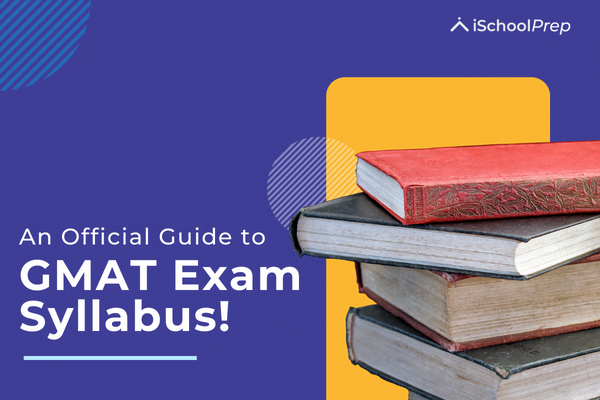Table of Contents
GMAT syllabus | An overview
GMAT, or Graduate Management Admission Test, is intended to assess essential skills like problem-solving, critical reasoning, and analytical writing, all of which are required for success in graduate management or business programs. The first step in GMAT prep is to learn about the GMAT syllabus and exam pattern and identify some preparation tips to help you achieve a high score. This article can help you with that as it explores the GMAT syllabus for online/ center-based tests.
GMAT exam pattern
- GMAT tests the candidates in four sections with two short breaks (optional). The four sections of the GMAT exam are-
- Analytical Writing
- Integrated Reasoning
- Quantitative section
- Verbal section
- The GMAT exam lasts 3 hours and 7 minutes, during which candidates must answer 80 questions. The score obtainable is between 200 and 800.
- Unofficial scores are visible on the screen post-test completion to enable students to plan their next steps.
GMAT exam questions
Let’s have a look at the number and types of questions asked in each section of the GMAT exam-
- Analytical writing assesses a candidate’s ability to analyze an argument in 30 minutes.
- The integrated reasoning section has 12 questions that candidates should answer in 30 minutes. The candidates can take an optional break for 8 minutes after this section.
- The quantitative section has 37 questions, of which 15 are from data sufficiency and 22 in problem-solving that candidates need to answer in 75 minutes. The candidates may take an 8 minutes break at this point.
- Candidates then attempt the verbal section comprising 41 multiple-choice questions, 12 of which are critical reasoning, 14 are reading comprehension, and 15 are sentence correction type questions. All these questions need to be completed in 75 minutes.
- Students have the privilege of choosing the order of topics they wish to attempt in the exam.
To ensure you are preparing in the right direction, take a keen look at the GMAT syllabus mentioned below.

GMAT syllabus | Section-wise details
GMAT evaluates candidates in four sections, and the GMAT syllabus for each section of the exam is as follows-
Integrated Reasoning
The integrated reasoning section of the GMAT syllabus checks the candidate’s ability in data analysis and information evaluation. The question types of this group are as follows-
- Multi-source reasoning– Candidates should compare, interpret and apply the information from passages, graphs, tables, diagrams, and other types of visual representation and draw inferences.
- Table analysis– From the spreadsheet, candidates should determine the answers to questions based on the topics: statistics, ratios, proportions, and probabilities.
- Graphics interpretation– The question is in the form of bar graphs, line graphs, or bubble graphs. Students need to interpret information, determine relationships, and make inferences.
- Two-part analysis– The questions ask candidates to calculate proportions and trade-offs. Candidates must also solve complex problems in verbal, quantitative, or a combination of both.
Verbal section
Students should read the excerpts and answer the following types of questions-
- Reading comprehension- The question gives a short or long passage, and candidates should infer and answer multiple-choice questions depending on the idea of the plot, logical structure, and style.
- Critical reasoning- Candidates need to understand the given arguments, evaluate them, and formulate an action plan to answer these questions.
- Sentence correction- The question underlines a part of the sentence that test takers have to correct and make free of any grammatical abnormality.
- The GMAT verbal section includes the following topics that students must prepare for-
- Rhetorical construction of the sentences
- Countable vs. uncountable
- Sentence correction, including error detection or omission
- Reading unseen passages
- Parallelism
- Subject-verb agreement
- Misplaced modifiers
Quantitative section
Candidates need to prepare for high-school-level math to clear this section. GMAT syllabus for the quant section includes the following topics-
- Arithmetic includes pre-algebra, algebra, fractions, simple and compound interest, exponents and roots, percentages, and set theory.
- Math Geometry covers lines and angles, polygons, circles, solids, and coordinate geometry.
- Numbers cover permutation and combination, probability, ratio and proportion, and decimals.
- Word problems include rate, time and work, mixtures, discounts, profit, and loss.
Analytical writing (AWA)
The GMAT analytical writing section asks test takers to analyze and write their views in an essay within 30 minutes. Candidates should interpret the prompt with proper arguments, recognize the motive, draft their content to be structurally correct, consider different opinions, and support them with examples and facts.
How to prepare for the GMAT exam online?
iSchoolPrep is a one-stop destination for you to prepare for the GMAT. Besides, you can learn 2x faster by utilizing the below-mentioned features-
- Personalized study plans and live workshops
- Sample question papers
- 30+ hours of video lessons
- Doubt resolutions
Key takeaways
- Students who dream of pursuing an MBA abroad need to appear for the GMAT. However, they must know about the GMAT syllabus and criteria to score well on the test.
- The four GMAT sections are analytical writing, integrated reasoning, quantitative, and verbal, where candidates can choose the order of preference for answering the questions.
- GMAT tests one question in Analytical Writing Assessment, 12 in Integrated Reasoning, 31 in Quantitative Reasoning, and 36 in Verbal Reasoning.
- Now that you know the GMAT syllabus, plan well to ace the exam.
We hope you found this blog on the GMAT exam syllabus informative. If you have any questions/suggestions, you can reach out to us or drop a comment.
Till then, happy studying!
Like this blog? Read next: GMAT critical reasoning questions | The ultimate guide!
FAQs
Question 1: Can you explain the GMAT math syllabus?
Answer 1: The GMAT quant or quantitative aptitude section asks candidates about data sufficiency and problem-solving question types.
Question 2: What is GMAT exam eligibility?
Answer 2: As far as academic qualification is concerned, any student with a bachelor’s degree from a recognized institute can take the GMAT.
Question 3: How to score high and get a perfect GMAT score?
Answer 3: Build a strategy to prepare for the GMAT exam, study regularly, practice study material, learn the fundamentals, and increase your speed.






